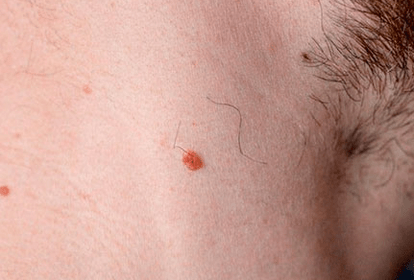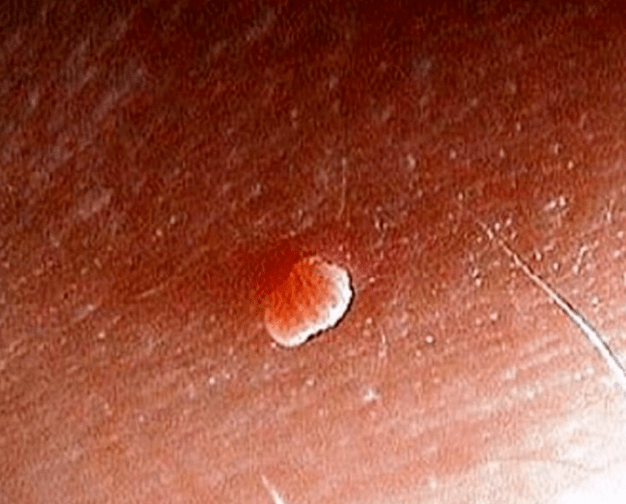Non -standard growth in skin cells is generally called neoplasms.As the main reason for the appearance of neoplasms, experts call for the effects of ultraviolet rays.

The second cause of skin damage is carcinogenic substances.Behind any new education on the skin, it is necessary to monitor and consult a doctor - oncologist in a timely manner.
He will carry out all the necessary diagnostic procedures.And it will recommend the other actions that you will have to carry out.
Papilloma, wart and condyloma - all this is a consequence of the activity of papillomavirus or HPV.The virus enters the human body and is inactive for a long time.Under the influence of provocation factors, activation of HPV occurs.This manifests itself by the formation of sweet growth on the skin and mucous membranes.
A neoplasm is capable of aggravating the quality of life, its cells are characterized by a mutation, leading to oncology.Diagnosis in a timely time and the treatment of papillomas on the genitals are the key to a healthy and folded intimate life of a woman.
The reasons for the appearance of papillomas in the mouth
The main reason for the appearance of growth in the mouth is the presence of human papillomavirus in the body.It is easy for them to be infected: the virus is transmitted to a domestic way and through personal contacts (contact, unprotected sex).The main methods of infection through the virus:
- No -Compliance with the rules of personal hygiene, the use of brushes and dental towels of other people;
- The household method consists of poor disinfection of objects and utensils used with an infected person;
- Personal contact with the carrier of the virus (kisses, oral sex, sex);
- The infection of the newborn virus occurs during the passage along the mother's birth channel, which is the carrier of HPV.
The incubation period of the disease may last for several years.HPV can only be found in successful tests.
There are a number of factors affecting the activation of the virus and the appearance of symptoms:
- Frequent colds and chronic inflammatory processes, a decrease in immunity;
- Stressful lifestyle and bad habits;
- Hormonal violations;
- Long -term contribution of antibiotics and corticosteroids (hormonal drugs);
- Gastrointestinal tract diseases;
- Pregnancy;
- Systematic injury of the mucosa of the mouth (using toothbrushes with hard hair, food and hot drinks, dentisation, adjustments);
- Caries, periodontal disease, gingivitis.
Any papilloma that appeared on the body is caused exclusively by HPV (human papillom virus).Papillomas in intimate places are a widespread phenomenon.The growths are in the groin, in the vagina, on the member, in the field of the anus.Often sexual papillomas are in children.Neoplasms can deliver them to the wearer not only, but also physical discomfort.According to medical statistics, the virus of the papillom of genitals is in almost a quarter of the population.
Papilloma training mechanism in the intimate area
In an inactive state, the sexual virus of the human papilloma is capable of living in the body for a fairly long period.The carrier of the virus can infect others, without knowing it.
The process of activating and growth of viral cells occurs when the body protection forces are weakened.As a result, neoplasms occur.
Unlike the general opinion that papilloma causes discomfort exclusively in cosmetic terms, it can also cause health problems.
HPV types
According to international standards, all neoplasms are divided into three types:
- Benign.
- Clever.
- Border (precancerous).
It is important to be able to determine the appearance of papillomas on the body.The type of neoplasm depends on the strain of the virus.
In most cases, people are faced with non -hazardous forms of infection, which do not harm health and cause only aesthetic discomfort.Just remove such a wart to forget discomfort.
The distinction of different types of warts on the body is quite simple by comparing various photos.Each type of education is characterized by a number of characteristics, knowing what is easy to suspect a particular form of the disease.
Ordinary papillomas or vulgar wart
The most common form of manifestation of the papillomavirus is ordinary papillomas, popularly called warts.They are caused by several viral strains, which are easily transmitted by contact and sexually.
According to statistics, approximately every third person on the planet at least once in their life fell on the advent of ordinary papillomas.
There are several types of papillomas in the mouth:
- Epithelial hyperplasia - Small formations in the form of taste buds, most often formed on the sides of the language;
- The simple (vulgar) papilloma appears in the sky and has the shape of an flattened cone;
- Vulgar papilloma;
- The growths on the gums are most often represented in the form of a flat papilloma;
- Flat papillomas;
- Cinema papillomas have a subtle base, which is often the cause of bleeding and inflammation, if they are injured.Are on a tongue bridle;
- N weblomes in the language;
- The pointed condylomas have the shape of a cone, are interconnected and form large homes of damage;
- Pointed papillomas

Important!Premature diagnosis threatens the growth of papillomatous nodes on the mucous membranes of the airways.
Papillomas on the tongue and the cheek can have a different shape.Polyps on the cheek are a small soft bump and do not cause pain.Language growths are subject to irritation and micro-grasses, which can cause bleeding.
Papillomas on tonsils are often confused with laryngitis or purulent throat.Due to growth, swelling of the respiratory tract and vocal cords can be observed, which causes difficulty breathing.
Unpleasant sensations accompany the process of food absorption or even liquid.Sometimes a person experiences the presence of a foreign body in their throat.
The appearance of papillomas on the larynx can be accompanied by changes in voice, respiratory problems.During the consumption of solid foods, the mucosa with growth can be crushed.The red throat in children can indicate the presence of growth.Larynx papillomatosis in children is the cause of bronchitis.
The appearance of pathological formations in the form of a cone or a polyp on gum (growth on gum) is dangerous insofar as the mucosa will be injured by a toothbrush or dental prostheses.In the end, this will lead to an inflammatory process and an infection of non -scar wounds.
Papillomavirus, in addition to skin changes, is a danger to the development of various diseases.The type of infection shows how it will develop and what is the danger.
Determination of the type of condyle is necessary for:
- Identification there is a risk of reborn growth in malignant tumor;
- selection of effective treatment;
- Determine the type of infection.
Simple
Also known as vulgar or ordinary.Papilloma formation is preceded by a slight burning sensation.
Over time, spherical growth appears, resembling a tumor.Even later, the smooth surface of the neoplasm turns into rough, and the color of the body passes darker.
The dimensions can vary from 1 to 10 mm.
Most often, ordinary warts appear between the fingers and on the palm of the rear.In children who mainly move, can be located on their knees.Are single and multiple.
Often, vulgar papillomas do not represent a danger to human health, representing benign growth.
Subanary
The name itself indicates the location of papillomas.In order not to confuse them with the horns, there are a number of speaking signs:
- The neoplasm on all signs looks like an ordinary wart;
- There are pain in the field of growth when you wear a small size shoe;
- There is no skin pattern and the surface is rough.
Verrocas Plantaires Papillomatosis Mosaic inherent, when bubbles are formed near the basic formation, over time - Papillomas.
In young children, plantar warts can disappear alone.
Flat
They have an oval shape, stretched, less often round.They are characterized by a slight height - only a few millimeters exceed above the skin.The face is affected, the skin of the upper part of the chest, sometimes external genitals.
The color is slightly darker than a body shade.Nearby, plane papillomas have the property of connecting to a single place, after which they become much more visible.
Movie
The warts characterized by a specific leg and a longitudinal shape are called nets (acrochordus).Initially, the lower neoplasm of the shape of a small cone, which is quickly stretched.
Most often in men and women after 40 years.They are located on the neck, on the eyelids, under the armpits, in the inguinal area, near the mammary glands.Often injured due to the presence of a thin leg, which is easy to damage with clothes or an inaccurate movement.
Sharp
Resemble external papillary education.They can affect the skin both by one and in whole groups.As they develop, they are combined in a single whole, forming a flesh or bright pink color of a comb.
The appearance of sharp warts is caused by a sexually transmitted infection.In this regard, condylomas affect the genitals, the inguinal area, the area near the anus.

The pointed papillomas develop very quickly and can occupy an extensive part of the healthy tissue in a few days.Even after a successful treatment, the relapse is not excluded.
Medicine has more than a hundred varieties of papillomavirus.About forty of them are sexually transmitted and consequently affect the genitals of men and women, many types of HPV do not do at all, some are particularly dangerous and can cause oncological diseases.
The types of human papillom virus are usual for classifying by the degree of probability of formation of oncogenic formations on the skin.Distinguish:
- A particularly dangerous type - 16, 18, 36, 45;
- The type of average danger is 31, 33, 35, 51, 52, 58;
- Sure type - 6, 11, 42, 43, 44.
HPV is a microorganism with up to a hundred stamps.Depending on the type that affects the person in the HPV stamp, different types of papillomas are also formed on the skin.They differ in appearance, the growth rate, the location on the body.
Certain papillomatous growths are detected on the mucous membranes of the oral cavity, in the bladder, in women of the vagina and in men of the penis.
The determination of the papillom of the species is necessary to select the most effective treatment method and assess the risk of rebirth of this malignant tumor.
Official medicine divides HPV into 4 groups:
- no oncogenic;
- weak oncogen;
- include an average oncogenic risk;
- Characterized by a high degree of carcinogeniccit.
Non-orcogenic, that is to say not to be reborn in a cancerous tumor over time, as a rule, of vulgar, flat and plantar gowms.If we take the general definition of the papillom, then, translated from Latin, you can characterize it as a "tumor in the form of a papilla".















